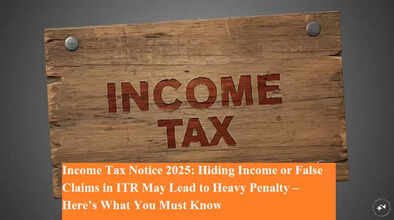Income Tax Notice 2025: Hiding Income or False Claims in ITR May Lead to Heavy Penalty – Here’s What You Must Know

New Delhi, July 4, 2025 – As the Income Tax Return (ITR) filing season for Assessment Year 2025-26 is in full swing, taxpayers are being strongly cautioned against errors and misinformation. The last date to file your ITR this year is September 15, 2025. Any discrepancy in income disclosure, invalid deductions, or use of the wrong ITR form can invite strict scrutiny and penalties from the Income Tax Department.
🔍 ITR Mistakes Can Trigger Income Tax Notices
This year, the tax department has increased its scrutiny. As per Section 143(2), nearly 1.65 lakh ITRs have been selected for detailed assessment — a significant rise compared to previous years.
Notices may be issued if:
-
Your Form 26AS or Annual Information Statement (AIS) does not match the income reported in your ITR.
-
You omit income sources such as:
-
Savings or FD interest
-
Rental income
-
Cryptocurrency gains
-
Foreign investments or capital gains
-
These mismatches raise red flags and may lead to further investigation under scrutiny provisions.
❌ False Claims Under 80C, HRA Can Be Costly
If you falsely claim deductions under sections like 80C, 80D, or HRA using incorrect or fake documents, the department can impose a penalty ranging from 50% to 200% of the tax underreported.
Even unreported high-value transactions, such as:
-
Cash deposits over ₹10 lakh
-
Credit card payments exceeding ₹2 lakh
-
Property purchases over ₹30 lakh
—can trigger suspicion and invite a notice if not disclosed properly in your return.
📋 Wrong ITR Form or Multiple Employers? Beware
Filing your ITR using an incorrect form or not consolidating income from multiple employers after a job change can be considered under-reporting or misreporting. Such errors may result in a notice under Section 139(9) (defective return) or scrutiny under Section 143(2).
If fake documentation is detected, penalties can be imposed under Section 271AAD, which deals specifically with false entries in financial records.
📨 What To Do If You Receive a Notice?
Receiving a tax notice can be alarming, but following the correct steps can help mitigate the issue:
-
Verify PAN and DIN: Ensure the notice is linked to your correct PAN and carries a valid Document Identification Number (DIN).
-
Identify the Section: Understand why you received the notice. For example:
-
Section 139(9) – Defective return
-
Section 143(1) – Preliminary assessment
-
Section 143(2) – Detailed scrutiny
-
-
Gather Supporting Documents: Collect proofs related to:
-
All income sources
-
Claimed deductions
-
Investments or transactions
-
-
Consult a Tax Expert: It’s advisable to take professional help to draft a response.
-
Reply Within Deadline: Timely and accurate responses can help avoid or reduce penalties.
💡 Tips to Avoid Income Tax Notices
-
Always cross-verify your AIS, TIS, and Form 26AS before filing.
-
Use the correct ITR form as per your income type.
-
Avoid inflating deductions or underreporting income.
-
Double-check capital gains, interest income, and rental income entries.
-
Reconcile bank accounts and PAN-linked transactions thoroughly.
🛑 Conclusion: Be Transparent, Be Safe
The Income Tax Department is using data analytics and AI tools to match real-time financial activity with filed ITRs. Hence, transparency and accuracy in your tax return are not optional anymore—they’re essential.
With increased scrutiny and stricter penalties in place, it’s critical that taxpayers file honestly, maintain proper documentation, and respond promptly to any official communication from the department.

